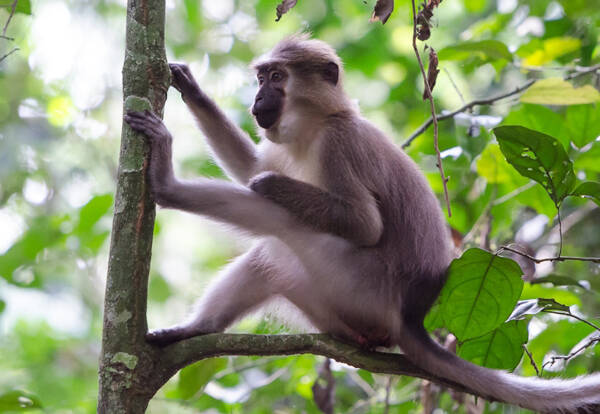Cercocebus agilis
IUCN
LCBasic Information
Scientific classification
- name:Cercocebus agilis
- Scientific Name:Cercocebus agilis,Agile mangabey,White-browed monkey
- Outline:Primates
- Family:Cercopithecidae Hoolock
Vital signs
- length:44-65cm
- Weight:5-13kg
- lifetime:About 20 years
Feature
The face has a white border
Distribution and Habitat
The Ajili white-browed monkey is found in Cameroon, Congo, Democratic Republic of Congo, Equatorial Guinea and Gabon.
The Ajili white-browed monkey usually lives in swamp forests near water, riverine forests or other seasonally flooded forests, and also appears in mountain forests. It is most commonly found on the ground or in the lower levels of the forest, and is active in the canopy layer up to about 10 meters.
Appearance
The male Ajili mangabey has a head and body length of 51-65 cm, and the female head and body length is 44-55 cm; the tail length is 45-79 cm; the male weighs 7-13 kg, and the female weighs 5-7 kg. It is a large, slender monkey with relatively long limbs, a long muzzle and large cheek pouches. The tail is longer than its body, often placed on the back, and tapers at the tip. Males are much larger than females. The hair is shorter and has different colored bands along its length, giving the coat an overall brown to gray appearance, with the back being darkest and a white or yellowish hazel appearance from the chin to the chest and abdomen. The skin of the adult Ajili mangabey's hands, feet, face and ears is black, and its tail is long and tapered, with white tufts at the end. The face has a white border, slightly protruding hair on the forehead, and often exposes a patch of pale skin. The Agillie mangabey lacks the distinctively pale eyelids that visually distinguish it from other s
Details
Agile mangabey (scientific name: Cercocebus agilis) is also known as Agile mangabey in English. There is no subspecies.

Agile mangabey lives in small groups of about 8-22 individuals, usually led by an adult male. The diet is diverse, including fruits, sprouts, seeds, young leaves, mushrooms and insects, and sometimes bird eggs and small vertebrates. Adult males have even been occasionally recorded killing and eating small antelopes. They have flexible large incisors and a strong jaw, which enables them to crack the shells of nuts and pods, which is not possible in other monkeys. They have large cheek pouches to facilitate the collection of food for later consumption.
The Ajili white-browed monkey can breed all year round, and the female's gestation period is about 6 months, with one baby born per litter. Like other white-browed monkeys, the female Ajili white-browed monkey will swell her genitals during the estrus period as a visual signal to announce that she is ready and can mate.
Listed in the 2008 Red List of Endangered Species of the World Conservation Union (IUCN) ver 3.1 - Least Concern (LC).
Listed in the CITES Appendix I and II of the Washington Convention on International Trade in Endangered Species.
Protect wild animals and eliminate game.
Maintaining ecological balance is everyone's responsibility!








